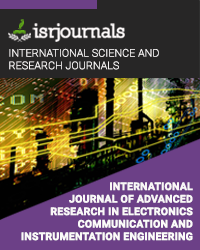investigation of ytterbium doped fiber amplifier in 1-m region for high gain enhancement
Reena Roslin Raj.I,P.Srinivasan,R.Vasanth,V.Vignesh
Published in International Journal of Advanced Research in Electronics, Communication & Instrumentation Engineering and Development
ISSN: 2347 -7210 Impact Factor:1.9 Volume:3 Issue:1 Year: 24 April,2021 Pages:553-559

Abstract
In this paper, The high power and high performance amplifiers are needed for application such as LIDAR, remote sensing and WDM transmission system. The adaptation of Ytterbium -doped amplifiers (YDFAs) can offer larger bandwidth, high dynamic range ,and multiwatt output power. The Non -linear effects of optical channel can be minimized by optimal selections of signal wavelength with proper channel spacing. Multiple numbers of channels are combined using CWDM and DWDM based multiplexing techniques .The signal wave length selected to be in the range [1020nm -1055nm].The input power were dynamically adjusted and based on channel condition These optimal selected signal wavelengths are amplified using YDFA based amplifier and distributed over fibers. The length and doping concentration in YDFA were optimized for larger OSNR. The pumping wave lengths are chosen in such way the excitation of Ytterbium ions takes places which can amplifier the input wavelength accordingly. The triple pumping method is utilized with pumping wavelength namely 900nm,940nm,and960nm to provide peak gain over bandwidth. The operating power of input and pump signal are kept at optimum levels. The data transmitted over distributed networks can be done to transports data between end points. Direct optical amplification is performed rather electrical conversions. The new set of optical generated carrier signals were generated for transmission with help of frequency offset and distributed to various optical network units. the optical switches are used to direct the channels to proper receiver end system.
Kewords
Ytterbium, Amplifier Region
Reference
1.Sharma SR, Sood T. Gain flattening of EDFA with hybrid EDFA/ Raman amplifier with reduced channel spacing. Int J Eng Dev Res. 2015;3:1–7. 2. D. Z. Mohammed and A. H. Al-Janabi, “Passively Qswitched erbium doped fiber laser based on double walled carbon nanotubes-polyvinyl alcohol saturable absorber,” Laser Phys., vol. 26, no. 11, pp.115108, 2016. DOI: 10.1088/1054-660X/26/11/115108. 3. D. Z. Mohammed and A. H. Al-Janabi, “Large diameter coreless fiber as a saturable absorber for erbium doped fiber laser cavity based on multimode interference,” Opt. Fiber Technol., vol. 50, pp. 212–215, 2019. DOI: 10.1016/j.yofte.2019.04.002. 4. A. H. Al-Janabi and D. Z. Mohammed. “Stability evaluation of passively Q-switched erbium doped fiber laser based on double and multi-walled carbon nanotubes,” in Frontiers in Optics, 2017, pp. FTu5A. 4. OSA Publishing/ Washington, D.C. United States. 5. W. A. Khaleel and A. H. Al-Janabi, “Erbium-doped fiber ring laser with wavelength selective filter based on nonlinear photonic crystal fiber Mach–Zehnder interferometer,” Laser Phys., vol. 27, pp. 105104, 2017. DOI: 10.1088/1555-6611/aa8287. 6. S. K. M. Al-Hayali, D. Z. Mohammed, W. A. Khaleel, and A. H. Al-Janabi, “Aluminum oxide nanoparticles as saturable absorber for C-band passively Q-switched fiber laser,” Appl. Opt., vol. 56, no. 16, pp.4720–4726, 2017. DOI: 10.1364/AO.56.004720. 7. K. Schuhmann, et al. “Multipass amplifiers with selfcompensation of the thermal lens,” Appl. Opt., vol. 57, pp. 10323–10333, 2018. DOI: 10.1364/AO.57.010323.

